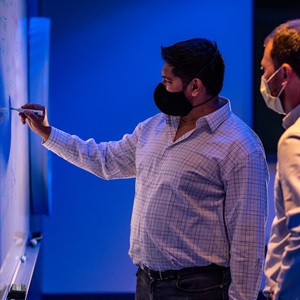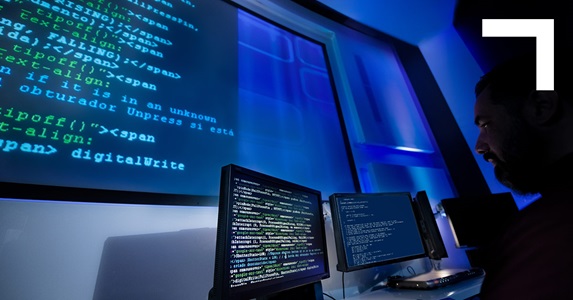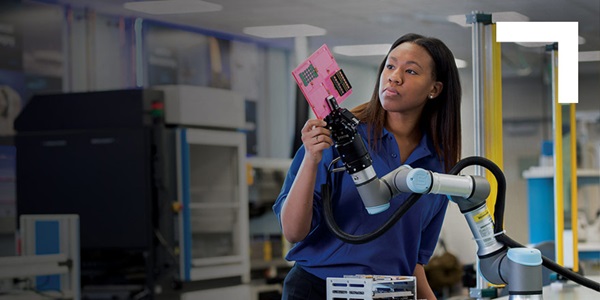Going DA/RC

By Elizabeth McCann
When autonomous aircraft systems such as Global Hawk took to the skies years ago, they seemed like something out of science fiction — planes flying above one continent while the pilot and sensor operators sat in another. Today, this kind of strategic autonomy is common, but engineers at Northrop Grumman aren't satisfied with the status quo. As a leader in digital transformation for defense, they're looking to what's next in battlefield management.
And they may have found the future of defense in a software system known as Distributed Autonomy/Responsive Control, or DA/RC.

Practical Playbook: The Distributed Advantage
DA/RC is often seen as an aircraft's brain. However, DA/RC program manager Craig Turner likens it to a play in a football game — but these analogies aren't exclusive.
During an individual play in a football game, players are each given specific assignments with the collective goal of advancing the ball. The quarterback drops back to throw a pass, the offensive linemen have blocking assignments, and the wide receivers are assigned pass routes to run. But things don't always go to plan, and if the opposing team does something unexpected, players and coaches don't have time to stop and think. They must react and respond on the fly.
In a football game, pass rushing might come from an unexpected direction, or a wide receiver's route could be blocked. Based on what they're seeing on the field, their experience from previous games and their own athletic ability, players can react and make changes within the rules of the game. Northrop Grumman’s customers’ environments share this need for real-time reactions when things don't go as planned, Turner explains — and DA/RC enables battlefield management teams to respond much like their football counterparts. Here, the "play" is the mission plan drafted by military leadership, and the players are the aircraft, many of which are autonomous systems. Using sensor data, DA/RC algorithms direct planes to replan routes, survey new areas, jam threats or identify targets, all within the rules of engagement. DA/RC can also improve accuracy and speed up decision-making for pilots in manned aircraft with onboard, digital decision aids.
DA/RC Makes Autonomous Systems Relevant in Real World Environments
DA/RC isn't simply a new software solution — it underpins a new approach to battle management.
Using DA/RC, air systems themselves can take on more autonomy and complete tasks within set parameters. For example, automating time-critical tactical decisions can increase accuracy and efficiency and allow pilots to focus on larger, more complex supervisory roles. Meanwhile, by distributing autonomy to each vehicle, missions can continue even in non-permissive environments where communication links may be jammed.
"When you're looking from above and you can see the entire battlespace with all participants and assignments, it enables you to make better decisions."
— Craig Turner, DA/RC Program Manager
DA/RC empowers more strategic decision-making by humans, increases overall battlefield visibility and keeps operators on the loop, including managing multiple aircraft at once. This allows the autonomous vehicles themselves take on more time critical tasks — such as flying, tracking vehicle status, pop-up threat detection and even choosing optimal flight paths to complete the mission, “dependent on commander’s desired outcome. DA/RC’s strength is in completing the objectives successfully even in extremely hostile environments.
The best way to see this software in action? Inside one of Northrop Grumman's DA/RC development labs, which make you feel like you've wandered onto the set of a modern spy thriller. Enormous wall monitors display satellite images of real-world geography dotted with the flight paths of dozens of manned and autonomous aircraft. Operators sit at banks of glowing computers, keeping an eye on the battle space and status of each vehicle. In all labs operators can participate in both simulated and real-world live exercises. Turner puts it simply: "A big part of our team is capturing tomorrow for the company." DA/RC has the potential to enable many future capture efforts for Northrop Grumman.
Joint Command and Control across All Domains
Northrop Grumman's DA/RC software also offers a way to reintegrate tactical decision making onboard unmanned vehicles. "As pilots are removed from the cockpit, there is a level of decision-making that is lost to tactically execute the mission," says Lisa Letcher, a manager of software engineering in the DA/RC program. "DA/RC is a way to enable putting some of those capabilities — some of that real-time tactical decision-making — back onboard the aircraft. It's a system that provides real-time tactical decision-making, which involves software and capabilities that can reside both onboard vehicles and at a location where an operator can command, control and interface with those vehicles."
DA/RC is also domain agnostic, meaning it can be used by any branch of military — air, land, sea or space — and could eventually be used by multiple services at once to improve tactical interoperability. Just as it reimagines how humans and machines collaborate, it also allows machines to have better conversations with one another, including systems from different service branches. DA/RC can help support the Joint All-Domain Command and Control (JADC2) framework of connecting distributed sensors, shooters and data from all domains to all forces.
Turner is clear about DA/RC's potential: "It's really like the 'God's eye view' in a video game," he says. "When you're looking from above and you can see the entire battlespace with all participants and assignments, it enables you to make better decisions." Even better? As battlefield management technology evolves, there's plenty of room for DA/RC to grow. As Turner says, "We're at the very beginning. That's why it's so exciting."
More Innovation Stories
Read all stories about advanced technology and innovation >>


